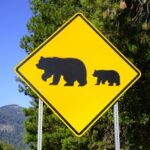Klimaatspeculatie over ecologie bereikt af en toe ook topbladen als Science. Vandaag bieden we repliek van een onderzoeker bij wie zorgvuldig waarnemen de basis vormt van al zijn werk: Dick Dekker.
Deze Neder-Canadees uit Alberta is een klassieke naturalist. Hij gaf toestemming voor plaatsing van zijn klimaatkritische artikel over wolven. Dekker deed 45 jaar waarnemingen aan wolven in Jasper National Park en Banff National Park, en promoveerde in Wageningen op zijn werk aan jachttactieken van slechtvalken.
Zijn gastposting behandelt claims uit een genetische studie van Musiani et al “Molecular and evolutionary history of melanism in North American gray wolves”in Science van 5 februari 2009.
Musiani claimde dat de zwarte wolvenvariant dankzij global warming de grijze wolf verdringen omdat er minder sneeuw zou vallen.
-
- Musiani claimt
- “It is somewhat ironic that a trait that was created by humans may now prove to be beneficial for wolves as they deal with human-caused changes to their habitat,”
Lees hier Dick Dekker’s artikel, waarin hij aantoont dat a. zwarte wolven vooral langs de westkust tot Alaska voorkomen en b. geen camouflagevoordeel blijken te hebben over grijze wolven en c. dat melanisme niet per sé van domesticatie komt.
Hoeveel zwarte wolven en waar?
Dekker: ‘Van de ongeveer 800 wolven die ik in Jasper National Park gezien heb, waren er ongeveer 70% zwart.In Alaska and Yellowstone, zijn 30-50% zwart. Een zwarte wolf kan na een paar jaar grijs, zilver of zelfs wit worden.Deze gegevens staan vermeld in mijn research papers en boeken.’
Nature Alberta 39(2):24-26 (Summer 2009).
Black Wolves and Climate Change
By Dr. Dick Dekker, Ph.D.
A group of 15 geneticists and biologists has recently written that the black fur of wolves is “a gift from the dogs” and that it gives them a camouflage advantage over their grey cousins if the tree line advances northward due to climate change.
Based on DNA analysis, the black fur is said to have been caused by a mutation that was lost to wolves in ancient times but was subsequently reacquired after wolves hybridized with domestic dogs. And this was most likely to have happened, the scientists speculated, about 15,000 years ago after some wolves crossed over from Asia into Alaska via the land bridge that developed between the two continents during the Pleistocene ice age.
In my opinion, the scientists exaggerated the significance of their finding by claiming that black wolves have an evolutionary edge over their grey cousins that makes them better adapted to climate change, because black fur, the scientists thought, gives a camouflage advantage to a forest-dwelling predator, especially if snow-free ground increases in extent due to climate warming.
These arguments are fanciful because the effects of climate change may vary in different landscapes. We Albertans have been told time and time again that a warmer and dryer climate is supposed to lead to the demise of our forests and create more open terrain. If so, the so-called camouflage advantage for a black animal would be lost. Furthermore, in my 45-years of field observations in Jasper National Park, black wolves are at all times more visible than grey ones, even among the trees.
The taxonomic origin of wolves is complicated and was vigorously debated at the Second North American Symposium on Wolves held at the University of Alberta in August of 1992. Based on the fossil record, Professor Ronald Nowak argued that the forbearer of all wolves is the Red Wolf of the American southwest. Long ago, the ancestors of these American wolves crossed over into Asia and Europe. There, they grew to the large size of the present-day Gray Wolf and much later returned to North America, where some acquired a black coat. Apparently there are no black wolves in Eurasia where all of them are grey.
Be that as it may, melanism in wild mammals is not confined to the Gray Wolf. It also occurs in the Red Fox, where it can have nothing to do with hybridization with dogs because foxes and dogs have different chromosome numbers, which prevents interbreeding. Melanism is also evident in squirrels, especially in the eastern Grey Squirrel. After this large species was introduced near Vancouver, the sight of black squirrels has become routine to visitors of Stanley Park.
Black fur has even been reported in our common Richardson’s Ground Squirrel or gopher. Colonies of black gophers have been seen in fields near Tofield and west of Edmonton, as well as in the Yukon and Jasper National Park.
So what is so exceptional about black fur in wolves, and why bring it up in the context of climate change? Or has climate change become the buzzword in wildlife research?






Misschien komen de wolven wel weer terug:
'Stijging zeespiegel leidde koude periode in'
http://www.telegraaf.nl/binnenland/6191619/___Sti…
Mooie beesten, die donkere wolven! En ja, je verbaast je er weer over hoe sommigen kans zien om AGW overal aan de haren bij te sleuren. Ik bedoel: melanisme heeft toch nog nooit aantoonbaar iets met een eventuele opwarming van de aarde te maken gehad. Het komt gewoon gemengd met de normale kleur in populaties van allerlei dieren voor, ongeacht het klimaat dat ergens heerst.
Check dit: http://www.telegraaf.nl/buitenland/6204916/__Wolf…
Wolf nu al op 100km van onze grens… ze komen zeker terug!!!